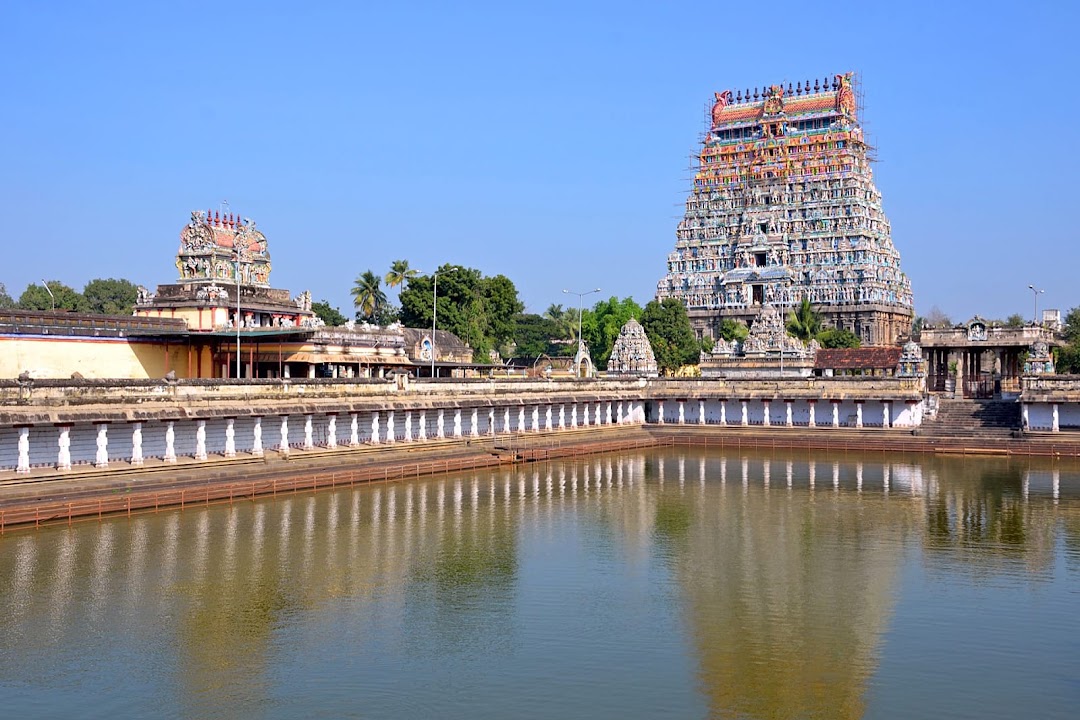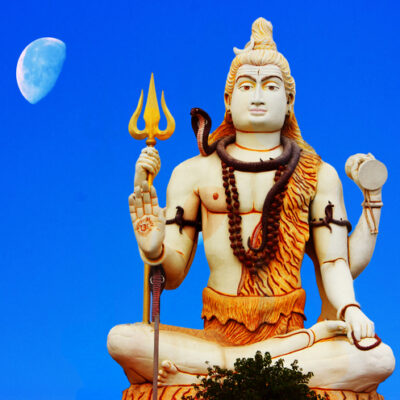Chidambaram Sri Thillai Natarajar Temple, (AETHER) Cuddalore

Address
Chidambaram Sri Natarajar Temple, Devasthanam, Chidambaram, Cuddalore District, PIN 608001 PH:9443986996
Deity
Natarajar, Kanagasabai, Amman: Sivagami
Introduction
- Location: Chidambaram, Tamil Nadu, India.
- Deity: Lord Nataraja (Shiva), the cosmic dancer.
- Historical Significance:
- Dates back to ancient times, with a Shiva shrine existing when the town was called Thillai.
- The present structure was built in the 10th century CE by the Cholas, who considered Nataraja their family deity.
- The temple has been restored and expanded over centuries, with most structures dating to the 12th–13th centuries.
- Architectural & Cultural Importance:
- Symbolizes the interconnection of art and spirituality.
- Walls feature 108 Karanas (dance postures) from the Natya Shastra, forming the basis of Bharatanatyam.
- Houses the earliest known Amman (Devi) temple in South India.
- Religious & Structural Features:
- Blends Shaivism, Shaktism, and Vaishnavism.
- Key shrines:
- Lord Nataraja performing the Ananda Tandava in the Pon Ambalam (golden hall).
- Shrines for Parvati (Amman), Ganesha, Murugan, and Vishnu.
- Pre-13th-century Surya shrine with a chariot.
- Features Shiva Ganga sacred pool and large mandapas (halls) for pilgrims.
Puranic Significance
Puranic Significance of Chidambaram Nataraja Temple
- Location & Origin:
- The legend is set in Thillai Vanam, a forest of Thillai trees (Excoecaria agallocha) near modern-day Chidambaram.
- The temple sculptures depicting Thillai trees date back to the 2nd century CE.
- The Divine Dance & Defeat of Rishis:
- A group of rishis in Thillai believed in the supremacy of magic and rituals.
- Lord Shiva, disguised as Pitchatanadar (a simple mendicant), entered the forest with Lord Vishnu as Mohini.
- The rishis, enraged by the effect of Shiva’s beauty on their wives, tried to defeat him through magical means:
- They invoked serpents, but Shiva adorned them as ornaments.
- They sent a fierce tiger, which he skinned and wore as a shawl.
- Finally, they summoned the demon Muyalakan, symbolizing arrogance and ignorance.
- Shiva subdued Muyalakan, performed the Ananda Tandava (Dance of Bliss), and revealed his true divine form.
- The rishis realized their folly and surrendered to Lord Shiva.
- Role of Sage Patanjali & Vyagrapathar:
- Adisesha, the divine serpent of Lord Vishnu, wished to witness the Ananda Tandava and was born as Sage Patanjali.
- Vyagrapathar (Pulikaalmuni), who had tiger-like feet for collecting fresh flowers for worship, joined Patanjali.
- Together, they worshipped Lord Shiva as Thirumoolataneswarar and witnessed the divine dance.
- Ananda Tandava Posture:
- The Ananda Tandava pose of Lord Nataraja is a globally recognized symbol of cosmic dance.
- It conveys the philosophy of creation, preservation, and destruction through dance.
Beliefs
Here Moolavar Thirumulanathar bestows blessings as a self-portrait. But, Natarajar is the main deity here. It is said that the worshipers of Eesan here get peace of mind and are cured of physical ailments. In particular, those who want to master the arts are confident that if they pray to SItalam Natarajar with devotion, they will have a better future as they wish.
Special Features
- Symbolism in Nataraja’s Dance Posture:
- Dancing Posture – Represents the eternal cycle of creation, preservation, and destruction.
- Demon Under Feet – Symbolizes ignorance being crushed.
- Fire in Hand – Represents the power of destruction.
- Raised Hand – A sign of protection and salvation.
- Ring at the Back – Symbolizes the cosmos.
- Drum in Hand – Signifies the origin of life and creation.
- Rare Thandava Posture:
- A unique dance pose of Lord Nataraja can be seen at Melakadambur Temple, 32 km from Chidambaram.
- In this temple, Nataraja is depicted dancing on a bull, surrounded by celestial beings.
- Chidambaram’s Sacred Names & Location:
- Also referred to as Thillai, named after the ancient Thillai forest.
- Known as Perumpatrapuliyur / Vyagrapuram, in honor of Saint Vyagrapathar.
- Believed to be at the “Lotus Heart of the Universe” (Virat Hridaya Padma Sthalam).
- Three Forms of Lord Shiva in the Sanctum:
- Sakala Thirumeni – Anthropomorphic form as Lord Nataraja.
- Sakala Nishkala Thirumeni – Semi-form as Chandramouleswarar (Crystal Linga).
- Nishkala Thirumeni – Formless Chidambara Rahasyam (an empty space representing Shiva as the cosmic void).
- One of the Panchabootha Sthalas (Five Elemental Temples):
- Chidambaram – Represents Space (Aakasha).
- Kanchipuram (Ekambareswarar Temple) – Represents Earth (Prithvi).
- Thiruvanaikaval (Jambukeswarar Temple, Tiruchirapalli) – Represents Water (Jala).
- Tiruvannamalai (Annamalaiyar Temple) – Represents Fire (Agni).
- Srikalahasti (Kalahasteeswara Temple) – Represents Wind (Vayu).
- Five Places Where Shiva Performed His Divine Dance (Sabhais):
- Chidambaram – Porsabhai (Golden Hall).
- Thiruvaalangadu – Rathina Sabhai (Ruby Hall).
- Courtallam – Chitra Sabhai (Hall of Paintings).
- Madurai Meenakshi Temple – Rajatha Sabhai / Velli Ambalam (Silver Hall).
- Tirunelveli Nellaiappar Temple – Thaamira Sabhai (Copper Hall).
Festivals
Six Annual Abhishekams of Lord Nataraja
- Marghazhi Thiruvaadhirai (December – January) – Represents the first pooja (early morning).
- Masi Chaturdashi (February – March) – Represents the second pooja.
- Chittirai Thiruvonam (April – May) – Represents the third pooja (Uchikalam – midday).
- Aani Uthiram / Aani Thirumanjanam (June – July) – Represents the fourth pooja (evening).
- Aavani Chaturdashi (August – September) – Represents the fifth pooja.
- Puratasi Chaturdashi (October – November) – Represents the sixth pooja (Arthajama – late night).
Most Important Festivals
- Marghazhi Thiruvaadhirai (December – January)
- Celebrated as Arudra Darshan, marking the divine cosmic dance of Lord Shiva.
- A grand abhishekam is performed, and the deity is taken in procession outside the sanctum.
- The temple car (Rathotsavam) is drawn by thousands of devotees.
- Aani Thirumanjanam (June – July)
- Another major abhishekam, with Lord Nataraja being bathed in sacred substances.
- This festival is highly revered, attracting large crowds.
Grand Abhishekam Ritual
- Lord Shiva is bathed only six times a year.
- The most elaborate abhishekam occurs on the night before Ardra Nakshatra (Full Moon in the Ardra constellation).
- Sacred offerings used for the ritual bath include:
- Milk
- Pomegranate juice
- Coconut water
- Ghee
- Oil
- Sandalwood paste
- Curds
- Holy ashes (Vibhuti)
Century/Period/Age
3000-4000 years old
Managed By
Hindu Religious and Charitable Endowments (HRCE)
Nearest Bus Station
Chidambaram
Nearest Railway Station
Chidambaram
Nearest Airport
Puducherry






